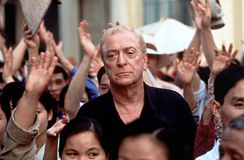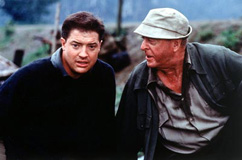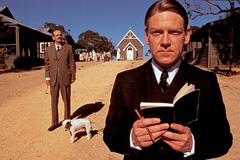The Quiet American (Phillip Noyce) 2002 / Rabbit-Proof
Fence (Phillip Noyce) 2002
 In what seems to be a deliberate attempt to distance
himself from the Hollywood action films that have come to define his career,
Australian filmmaker Phillip Noyce has directed two artier, less
sensationalistic features, that happen to be opening in America within a week of
each other. Unfortunately, both films fail precisely because Noyce attempts to
apply the sort of directorial shorthand that works best in a mindless action
movie onto a story that begs for a more studied approach. The Quiet American,
the first of the two films to come out, is an adaptation of Graham Green’s
novel. Workmanlike where it should be sensual, it fails to capture the romantic
obsessions that dominate Greene's work as well as The End of the Affair
and fails to match the expressionistic intrigue of The Third Man. More
than anything, it feels like Peter Weir’s The Year of Living Dangerously,
which is to say it flirts with provocative material, but ends up being mostly
superficial. Symbols from the novel are present here and they should work,
but they don't feel at all organic because Noyce fouls up the context.
In what seems to be a deliberate attempt to distance
himself from the Hollywood action films that have come to define his career,
Australian filmmaker Phillip Noyce has directed two artier, less
sensationalistic features, that happen to be opening in America within a week of
each other. Unfortunately, both films fail precisely because Noyce attempts to
apply the sort of directorial shorthand that works best in a mindless action
movie onto a story that begs for a more studied approach. The Quiet American,
the first of the two films to come out, is an adaptation of Graham Green’s
novel. Workmanlike where it should be sensual, it fails to capture the romantic
obsessions that dominate Greene's work as well as The End of the Affair
and fails to match the expressionistic intrigue of The Third Man. More
than anything, it feels like Peter Weir’s The Year of Living Dangerously,
which is to say it flirts with provocative material, but ends up being mostly
superficial. Symbols from the novel are present here and they should work,
but they don't feel at all organic because Noyce fouls up the context.
 Unfortunately, the performances in The Quiet American don't feel
organic either, and while the heavily plot-driven film never
really grows dull, sometimes I wished it would so the environments might have a
chance to feel a bit more lived in. What's the point of an exotic setting in a
movie about sexual obsession if nothing is allowed to become a fetish object?
Though the film’s cinematographer is frequent Wong Kar-Wai collaborator
Christopher Doyle, it has none of the intoxicating mood of Wong’s movies.
Instead of allowing the audience a moment or two to appreciate the way that
Vietnam offers temptation - be it opium, women, or power - to those who aren’t
acquainted with its mysteries, the film rushes along with a decent, but not
revelatory, espionage plot. This focus, which comes at the expense of fleshing
out Michael Caine’s character in any meaningful way, suggests that Noyce’s
attraction to this material was pretty similar to his decision to adapt any of
the Tom Clancy thrillers. As soon as Noyce establishes Greene’s cynicism with
the opening narration, he discards it, and begins working toward a far less
interesting emotion: political outrage.
Unfortunately, the performances in The Quiet American don't feel
organic either, and while the heavily plot-driven film never
really grows dull, sometimes I wished it would so the environments might have a
chance to feel a bit more lived in. What's the point of an exotic setting in a
movie about sexual obsession if nothing is allowed to become a fetish object?
Though the film’s cinematographer is frequent Wong Kar-Wai collaborator
Christopher Doyle, it has none of the intoxicating mood of Wong’s movies.
Instead of allowing the audience a moment or two to appreciate the way that
Vietnam offers temptation - be it opium, women, or power - to those who aren’t
acquainted with its mysteries, the film rushes along with a decent, but not
revelatory, espionage plot. This focus, which comes at the expense of fleshing
out Michael Caine’s character in any meaningful way, suggests that Noyce’s
attraction to this material was pretty similar to his decision to adapt any of
the Tom Clancy thrillers. As soon as Noyce establishes Greene’s cynicism with
the opening narration, he discards it, and begins working toward a far less
interesting emotion: political outrage.
 Political outrage seems to be the impetus for Rabbit-Proof
Fence, Noyce’s second, and less successful, film to come out this year.
Set in Australia in 1931, the film attempts to dramatize the plight of the
“stolen generations” of Aboriginal children who were seized by the
Australian government. What the film has in good intentions it loses with its
execution, however. The strict focus of the film isn’t on the reasons that the
laws were instituted that allowed this tragedy to occur repeatedly or the
attitudes that lead to the decision to repeal it. Instead, it follows three of
the children, Homeward Bound-style, as they trudge across the Island
Continent in a 1,500 mile, 9-week long journey. Cinematographer Doyle has a chance
to do better work here thanks to the scenery, but it can’t compare to the
otherworldliness of films such as Nicholas Roeg’s superior Walkabout.
Whenever Rabbit does attempt to create a villain, such as it does with
Kenneth Branagh’s impossibly white monster Mr. Neville, it overplays its hand
by encouraging modern audiences to judge them by today’s standards instead of
those of the time in which the story is set. Perhaps Noyce’s focus on the
journey itself is for the best, because simplemindedness is less of an issue
that way. In both films, Noyce punctuates the dramatic climaxes with a heaping
dose of slow-motion that do less to boost audience comprehension of the moment
than they do to milk it. Crass manipulations of this sort seem the exact wrong
thing to do when attempting to make a cogent political argument, but they’re
the best Noyce has to work with in either film, it seems.
Political outrage seems to be the impetus for Rabbit-Proof
Fence, Noyce’s second, and less successful, film to come out this year.
Set in Australia in 1931, the film attempts to dramatize the plight of the
“stolen generations” of Aboriginal children who were seized by the
Australian government. What the film has in good intentions it loses with its
execution, however. The strict focus of the film isn’t on the reasons that the
laws were instituted that allowed this tragedy to occur repeatedly or the
attitudes that lead to the decision to repeal it. Instead, it follows three of
the children, Homeward Bound-style, as they trudge across the Island
Continent in a 1,500 mile, 9-week long journey. Cinematographer Doyle has a chance
to do better work here thanks to the scenery, but it can’t compare to the
otherworldliness of films such as Nicholas Roeg’s superior Walkabout.
Whenever Rabbit does attempt to create a villain, such as it does with
Kenneth Branagh’s impossibly white monster Mr. Neville, it overplays its hand
by encouraging modern audiences to judge them by today’s standards instead of
those of the time in which the story is set. Perhaps Noyce’s focus on the
journey itself is for the best, because simplemindedness is less of an issue
that way. In both films, Noyce punctuates the dramatic climaxes with a heaping
dose of slow-motion that do less to boost audience comprehension of the moment
than they do to milk it. Crass manipulations of this sort seem the exact wrong
thing to do when attempting to make a cogent political argument, but they’re
the best Noyce has to work with in either film, it seems.
The Quiet American - * * 1/2
Rabbit-Proof Fence - * *
11-23-02
Jeremy Heilman